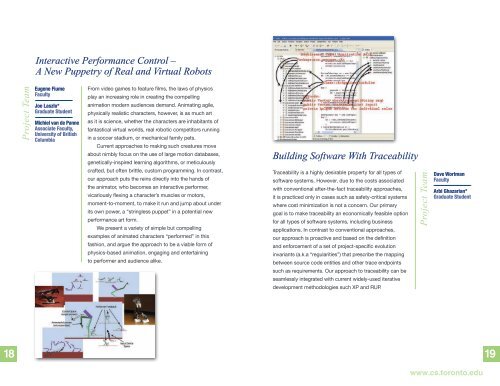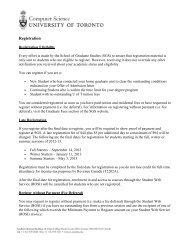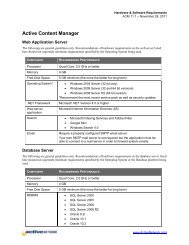Research in Action 2008 - University of Toronto
Research in Action 2008 - University of Toronto
Research in Action 2008 - University of Toronto
Create successful ePaper yourself
Turn your PDF publications into a flip-book with our unique Google optimized e-Paper software.
16<br />
Interactive Performance Control –<br />
A New Puppetry <strong>of</strong> Real and Virtual Robots<br />
Project Team<br />
Eugene Fiume<br />
Faculty<br />
Joe Laszlo*<br />
Graduate Student<br />
Michiel van de Panne<br />
Associate Faculty,<br />
<strong>University</strong> <strong>of</strong> British<br />
Columbia<br />
From video games to feature films, the laws <strong>of</strong> physics<br />
play an <strong>in</strong>creas<strong>in</strong>g role <strong>in</strong> creat<strong>in</strong>g the compell<strong>in</strong>g<br />
animation modern audiences demand. Animat<strong>in</strong>g agile,<br />
physically realistic characters, however, is as much art<br />
as it is science, whether the characters are <strong>in</strong>habitants <strong>of</strong><br />
fantastical virtual worlds, real robotic competitors runn<strong>in</strong>g<br />
<strong>in</strong> a soccer stadium, or mechanical family pets.<br />
Current approaches to mak<strong>in</strong>g such creatures move<br />
about nimbly focus on the use <strong>of</strong> large motion databases,<br />
genetically-<strong>in</strong>spired learn<strong>in</strong>g algorithms, or meticulously<br />
crafted, but <strong>of</strong>ten brittle, custom programm<strong>in</strong>g. In contrast,<br />
our approach puts the re<strong>in</strong>s directly <strong>in</strong>to the hands <strong>of</strong><br />
the animator, who becomes an <strong>in</strong>teractive performer,<br />
vicariously flex<strong>in</strong>g a character’s muscles or motors,<br />
moment-to-moment, to make it run and jump about under<br />
its own power, a “str<strong>in</strong>gless puppet” <strong>in</strong> a potential new<br />
performance art form.<br />
We present a variety <strong>of</strong> simple but compell<strong>in</strong>g<br />
examples <strong>of</strong> animated characters “performed” <strong>in</strong> this<br />
fashion, and argue the approach to be a viable form <strong>of</strong><br />
physics-based animation, engag<strong>in</strong>g and enterta<strong>in</strong><strong>in</strong>g<br />
to performer and audience alike.<br />
Build<strong>in</strong>g S<strong>of</strong>tware With Traceability<br />
Traceability is a highly desirable property for all types <strong>of</strong><br />
s<strong>of</strong>tware systems. However, due to the costs associated<br />
with conventional after-the-fact traceability approaches,<br />
it is practiced only <strong>in</strong> cases such as safety-critical systems<br />
where cost m<strong>in</strong>imization is not a concern. Our primary<br />
goal is to make traceability an economically feasible option<br />
for all types <strong>of</strong> s<strong>of</strong>tware systems, <strong>in</strong>clud<strong>in</strong>g bus<strong>in</strong>ess<br />
applications. In contrast to conventional approaches,<br />
our approach is proactive and based on the def<strong>in</strong>ition<br />
and enforcement <strong>of</strong> a set <strong>of</strong> project-specific evolution<br />
<strong>in</strong>variants (a.k.a “regularities”) that prescribe the mapp<strong>in</strong>g<br />
between source code entities and other trace endpo<strong>in</strong>ts<br />
such as requirements. Our approach to traceability can be<br />
seamlessly <strong>in</strong>tegrated with current widely-used iterative<br />
development methodologies such XP and RUP.<br />
Project Team<br />
Dave Wortman<br />
Faculty<br />
Arbi Ghazarian*<br />
Graduate Student<br />
18 19<br />
www.cs.toronto.edu





